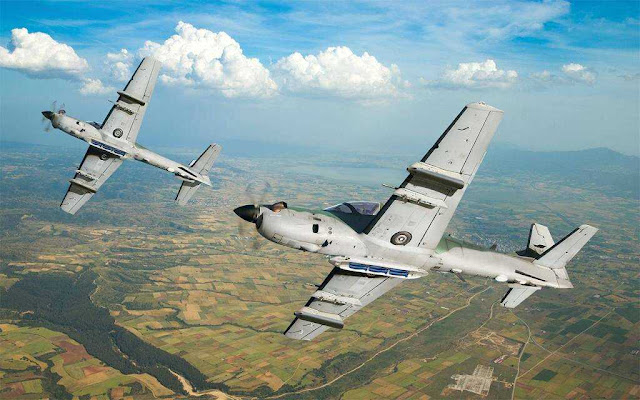The Embraer EMB 314 Super Tucano, also named ALX or A-29, is a Brazilian turboprop light attack aircraft designed and built by Embraer as a development of the Embraer EMB 312 Tucano.
The Embraer EMB 314 Super Tucano carries a wide variety of weapons, including precision-guided munitions, and was designed to be a low-cost system operated in low-threat environments.
The Embraer 314, first appeared in the light as the Emb-312H in the early '90s, it was essentially a larger version of the coach Embraer 312 (Tucano). Although it looks very much like the trainer aircraft that preceded it, the 314 is a very different plane, which stands out for its size.
The Super Tucano is longer and taller than its predecessor, due to the need to accommodate a more powerful engine, which allows for more power and greater speeds. And thus making it more appropriate to the tasks for which it was designed.
The Super Tucano was evolved into two distinct airframes. The single-seat version was known as the A-29A and achieved first flight on June 2nd, 1999. This model was a dedicated light attack and armed reconnaissance platform and could fulfill the offensive needs required by the Brazilian Air Force. The twin-seat derivative became the dual-control A-29B and achieved first flight on October 22nd of that same year. This particular model could be equally suited up for the task of light attack and armed reconnaissance or double suitably as a surveillance mount if called upon while also acting as a two-seat trainer for an instructor and student seated in tandem (the addition of the second cockpit deletes an internal fuel tank as found on the A-29A model).
Developed with affordability in mind, the Super Tucano has already proven to be a global success with operators numbering nearly twenty.
The Super Tucano is cleared to use all manner of modern, in-service missiles and bombs as well as rocket and gun pods. This showcases an inherent versatility required of counter-insurgency platforms sought after by global powers to fight today's wars.
A second crewman in the tandem seating arrangement reduces pilot load and increases situational awareness - therefore longer mission times and enhanced survivability can be had.
In addition to its manufacture in Brazil, Embraer has set up a production line in the United States in conjunction with Sierra Nevada Corporation for the manufacture of EMB-314 Super Tucanos to many export customers.
Specifications (EMB 314 Super Tucano)
General characteristics
- Year: 2003
- Manufacturer: Embraer Defense and Security (Embraer SA) - Brazil
- Crew: 2 (Pilot plus one navigator/student in tandem on Martin Baker Mk 10 LCX zero-zero ejection seats)
- Length: 11.38 m (37 ft 4 in)
- Wingspan: 11.14 m (36 ft 7 in)
- Width: 11.15 meters
- Height: 3.97 m (13 ft 0 in)
- Empty weight: 3,200 kg (7,055 lb)
- Max takeoff weight: 5,400 kg (11,905 lb)
- Powerplant: 1 x Pratt & Whitney Canada (PWC) PT6A-68C turboprop engine developing 1,604 horsepower driving a five-bladed propeller unit at the nose.
Performance
- Maximum speed: 590 km/h (370 mph, 320 kn)
- Cruise speed: 520 km/h (320 mph, 280 kn)
- Stall speed: 148 km/h (92 mph, 80 kn)
- Range: 1,330 km (830 mi, 720 nmi)
- Combat range: 550 km (340 mi, 300 nmi) (hi-lo-hi profile, 1,500 kg (3,307 lb) of external stores)
- Ferry range: 2,855 km (1,774 mi, 1,542 nmi)
- Endurance: 8 hours 24 minutes
- Service ceiling: 10,668 m (35,000 ft)
- Rate of climb: 16.4 m/s (3,230 ft/min)
Armament
2 x 12.7mm FN Herstal M3P Heavy Machine Guns (HMGs) in wing (one per wing); Externally-held ordnance across four underwing hardpoints (two hardpoints to a wing) and 1 x Fuselage centerline hardpoint. Armament types include Air-to-Air Missiles (AAMs), Air-to-Surface Missiles (ASMs), rocket pods, gun pods, cannon pods, precision-guided bombs, conventional drop bombs, and jettisonable fuel stores.
Operators
Afghanistan; Angola; Brazil; Burkina Faso; Chile; Colombia; Dominican Republic; Ecuador; Ghana; Honduras; Indonesia; Lebanon; Mali; Mauritania; Nigeria; Philippines; Senegal; United States


















EmoticonEmoticon